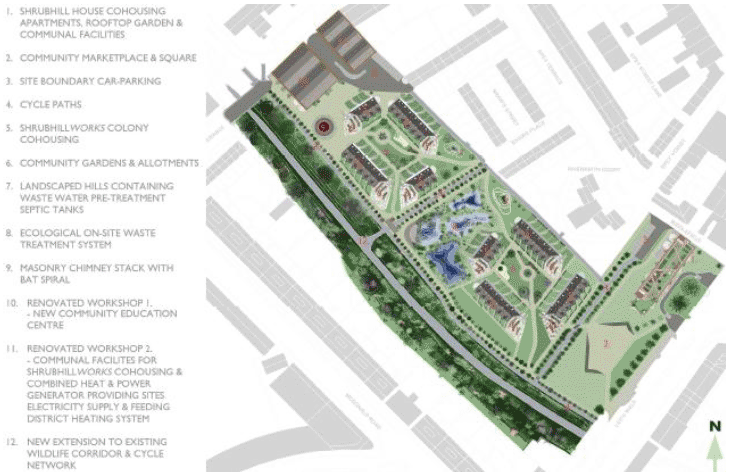Making the most of communities' natural assets: green infrastructure
An information note for Community Planning Partnerships on applying an ecosystems approach.
Building on good practice - practical examples
The following are some examples where decision-makers have used some of these steps to enhance local benefits from working with nature and building green infrastructure. In some cases, decision-makers have come together to integrate their activities towards common goals through Community Planning Partnerships.
Development planning and place-making
Techniques such as Charrettes (Scottish Sustainable Communities Initiative) and Enquiry by Design (e.g. in Aberdeenshire, Caithness, East Ayrshire) have been used in different parts of Scotland to engage communities in new development proposals. Similar processes can be applied to existing settlements to help shape the many activities undertaken by the public sector. Existing assets, whether natural or built, can form the basis for new, green infrastructure that is relevant to the community.
The guide Green Infrastructure: Design and Place-making includes examples of incorporating green infrastructure into building and urban design at different scales - from a building to a neighbourhood to a region.
Seven Lochs Wetland Park Masterplan is a key green network element of the Gartloch-Gartcosh community growth area which will see 4500 new homes created in the area over the next 15 years. The Masterplan sets out a vision, costed proposals for the site split over 3 phases, recommends how it should be developed and identifies possible funding sources. The Gartloch Gartcosh Strategic Delivery Partnership is consulting widely on the draft plan to secure community and political support for the project.

Shrubhill Works
The 2011 winner of the Integrated Habitats Design Competition was a design for adapting a brownfield site for housing at Shrubhill, Leith. The judges commented "This project integrates community, energy, materials, water, food and biodiversity, transforming a run-down inner city site into a water sensitive urban village with permaculture at its heart. Integration comes in the form of waste and wastewater treatment and rooftop gardens. The site includes plenty of wildlife habitat which links to the wider ecological network and species, including bats, birds and bees."
Funding and investment
Clackmannanshire Council, with support from the Central Scotland Green Network Development Fund, has developed a strategy and framework for decision-making on future investment in a range of green network projects across the Council area. Working in partnership with the Clackmannanshire Alliance (the Community Planning Partnership for Clackmannanshire), Forestry Commission Scotland and Action for Change, the project brought together information from a variety of sources to produce a vision and action plan for the future management of, and investment in, the green network in Clackmannanshire. This will target resources at projects which will have the biggest impact on the health and well-being of Clackmannanshire's residents. The study is also helping to develop the Local Development Plan and related Open Space Strategy.
Water and drainage infrastructure
The Metropolitan Glasgow Strategic Drainage Scheme Partnership aims to provide a holistic approach to managing surface water which will reduce flood risk and unlock development potential while improving water quality and allowing residential areas to co-exist with the natural landscape.
Economic regeneration and use of vacant/derelict land
Central Scotland Forest Trust, with support from the Central Scotland Green Network Development Fund, identified vacant and derelict land sites in North Lanarkshire suitable for woodland planting for the International Children's Games 2011 Legacy Project, to help the organising committee realise their ambition to deliver a carbon neutral Games. The methodology devised identified a number of sites which are suitable for planting and the funding and implementation of these are being explored by the Trust and the Forestry Commission Scotland. In addition, links with Beautiful North Lanarkshire have been established which should also lead to implementation of some schemes by volunteer groups.
Irvine Bay Green Network Strategy focuses on the greening of derelict industrial sites and contaminated land to create and restore accessible greenspace and wildlife habitats. The strategy explores both permanent and temporary solutions for sites awaiting development and the action plan contains costed proposals for five key sites. Projects are now being taken forward including at Riverside Business Park.
Health
Tayside Woods for Health is an initiative led by three neighbouring Ranger Services working in partnership with NHS Tayside Health Board, other participant mental health services and local Community Planning Partnerships. It has established programmes of outdoor nature-focused activity; structured around the John Muir Award scheme to supplement traditional forms of care provided for mental health support service users. Social Return on Investment ( SRoI) evaluation of the 2010 pilot demonstrated the scope for outdoor 'green prescription' activities, with an estimated social return of £9.30 for every £1 invested. Programmes have been developed in Perth and Kinross, Angus and Dundee.
Royal Edinburgh Community Gardens is a 3-acre community garden within the Royal Edinburgh Hospital grounds in Morningside. It involves a diverse range of volunteers of all ages, abilities and social backgrounds. It was established to pilot a community-based approach to maintaining and improving health and well being, promoting healthy eating, outdoor exercise and volunteering opportunities. The gardens are now open three days a week and encourage members of the public, community associations, local charities, users of mental health services and hospital in-patients to get involved. Initially part-funded by Central Scotland Green Network and Scottish Natural Heritage, NHS Lothian has recently contributed to the project's core costs of approximately £26,000k per annum.
Contact
There is a problem
Thanks for your feedback